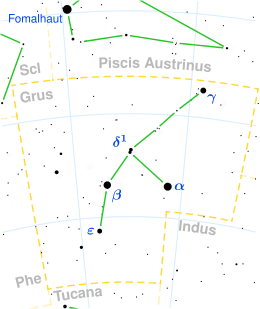Beta Gruis
| Observation data Epoch J2000 Equinox J2000 | |
|---|---|
| Constellation | Grus |
| Right ascension | 22h 42m 40.05027s[1] |
| Declination | −46° 53′ 04.4752″[1] |
| Apparent magnitude (V) | 2.146[2] (2.0 - 2.3[3]) |
| Characteristics | |
| Spectral type | M5 III[4] |
| U−B color index | +1.757[2] |
| B−V color index | +1.620[2] |
| Variable type | SRb[3] |
| Astrometry | |
| Radial velocity (Rv) | +1.6[5] km/s |
| Proper motion (μ) | RA: +135.16[1] mas/yr Dec.: −4.38[1] mas/yr |
| Parallax (π) | 18.43 ± 0.42[1] mas |
| Distance | 177 ± 4 ly (54 ± 1 pc) |
| Details | |
| Mass | 2.4[6] M☉ |
| Radius | 180[7] R☉ |
| Luminosity | 2,500[7] L☉ |
| Surface gravity (log g) | 0.4[7] cgs |
| Temperature | 3,480[8] K |
| Metallicity [Fe/H] | 0.0[7] dex |
| Other designations | |
| Database references | |
| SIMBAD | data |
Beta Gruis (β Gruis, β Gru) is the second brightest star in the southern constellation of Grus. It was once considered the rear star in the tail of the constellation of the (Southern) Fish: it, with α, δ, θ. ι, and λ Gru, belonged to Piscis Austrinus in medieval Arabic astronomy.[10]
This is a red giant star[3] with an estimated mass of about 2.4 times that of the Sun and a surface temperature of approximately 3,480 K,[8] just over half the surface temperature of the Sun. This low temperature accounts for the dull red color of an M-type star. The total luminosity is about 2,500 times that of the Sun, and it has estimated 180 times the Sun's radius.[6]
Beta Gruis is a type semiregular variable (SRb) star that varies in magnitude by about 0.4. It varies between intervals when it displays regular changes with a 37-day periodicity and times when it undergoes slow irregular variability.[3]
Beta Gruis played a crucial part in Perth Observatory's tracking of comet 2000 WM1 LINEAR in December 2001.[11]
References
- 1 2 3 4 5 van Leeuwen, F. (November 2007), "Validation of the new Hipparcos reduction", Astronomy and Astrophysics, 474 (2): 653–664, arXiv:0708.1752
 , Bibcode:2007A&A...474..653V, doi:10.1051/0004-6361:20078357
, Bibcode:2007A&A...474..653V, doi:10.1051/0004-6361:20078357 - 1 2 3 Gutierrez-Moreno, Adelina; et al. (1966), "A System of photometric standards", Publ. Dept. Astron. Univ. Chile, Publicaciones Universidad de Chile, Department de Astronomy, 1: 1–17, Bibcode:1966PDAUC...1....1G
- 1 2 3 4 Otero, S. A.; Moon, T. (December 2006), "The Characteristic Period of Pulsation of β Gruis", The Journal of the American Association of Variable Star Observers, 34 (2): 156–164, Bibcode:2006JAVSO..34..156O
- ↑ Houk, Nancy (1978), "Michigan catalogue of two-dimensional spectral types for the HD stars", Ann Arbor : Dept. of Astronomy, Ann Arbor: Dept. of Astronomy, University of Michigan, 2, Bibcode:1978mcts.book.....H
- ↑ Wielen, R.; et al. (1999), "Sixth Catalogue of Fundamental Stars (FK6). Part I. Basic fundamental stars with direct solutions", Veröff. Astron. Rechen-Inst. Heidelb, Astronomisches Rechen-Institut Heidelberg, 35 (35), Bibcode:1999VeARI..35....1W
- 1 2 Gondoin, P. (December 1999), "Evolution of X-ray activity and rotation on G-K giants", Astronomy and Astrophysics, 352: 217–227, Bibcode:1999A&A...352..217G
- 1 2 3 4 Judge, P. G. (November 1986), "Constraints on the Outer Atmospheric Structure of Late Type Giant Stars with IUE Application to Alpha-Tauri K5III and Beta-Gruis M5III", Monthly Notices of the Royal Astronomical Society, 223 (2): 239, Bibcode:1986MNRAS.223..239J, doi:10.1093/mnras/223.2.239
- 1 2 Engelke, Charles W.; Price, Stephan D.; Kraemer, Kathleen E. (October 2006), "Spectral Irradiance Calibration in the Infrared. XVI. Improved Accuracy in the Infrared Spectra of the Secondary and Tertiary Standard Calibration Stars", The Astronomical Journal, 132 (4): 1445–1463, Bibcode:2006AJ....132.1445E, doi:10.1086/505865
- ↑ "V* bet Gru -- Variable Star", SIMBAD, Centre de Données astronomiques de Strasbourg, retrieved 2010-01-05
- ↑ Allen, R. H. (1963), Star Names: Their Lore and Meaning (rep ed.), New York, NY: Dover Publications Inc., p. 238, ISBN 0-486-21079-0
- ↑ "Astronomy News". December 16, 2001.
External links
- MSN Encarta (Archived 2009-10-31)
Coordinates: ![]() 22h 42m 40.1s, −46° 53′ 05″
22h 42m 40.1s, −46° 53′ 05″
